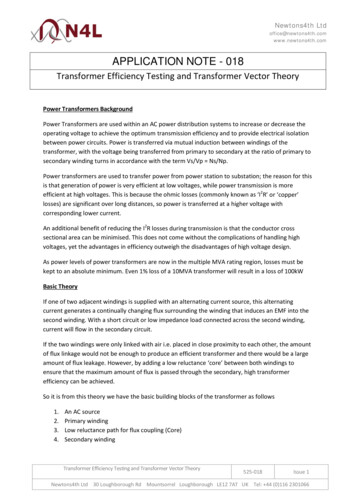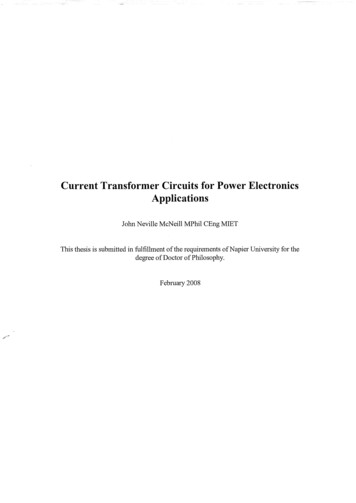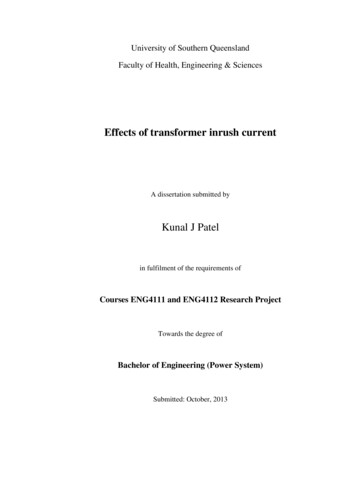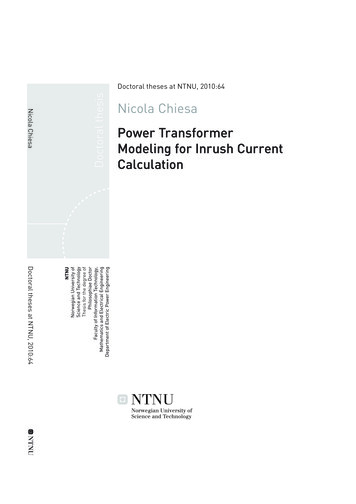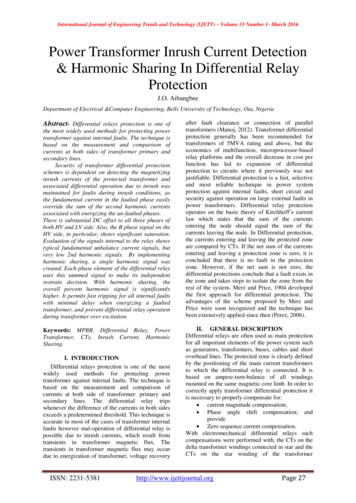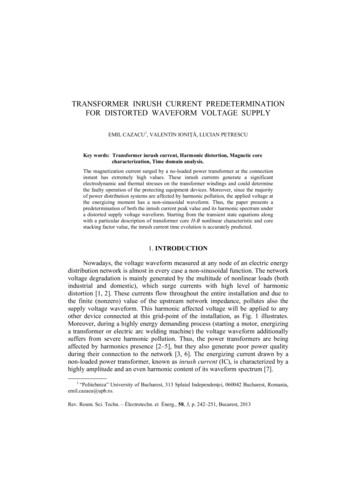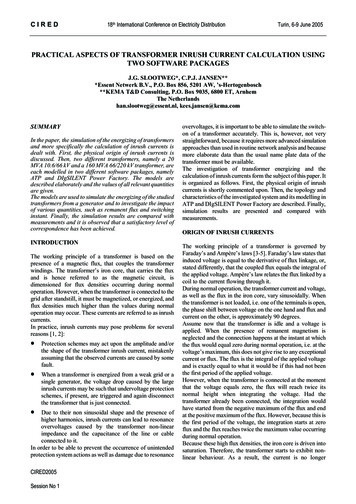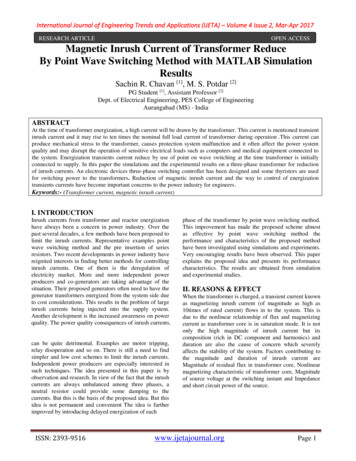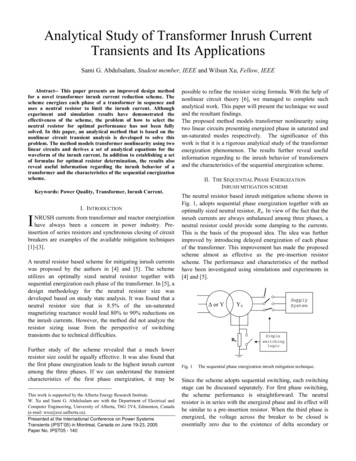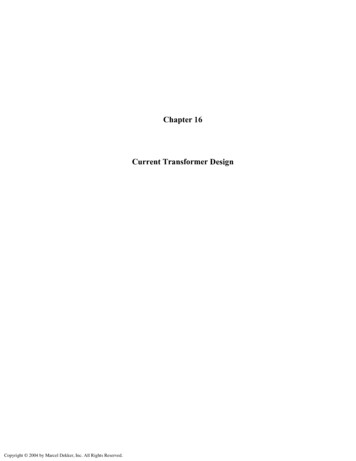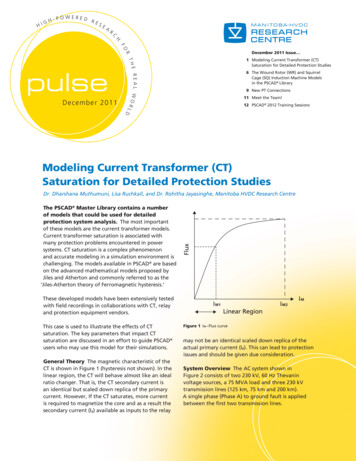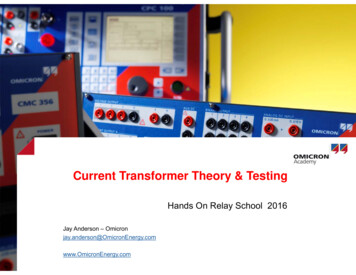
Transcription
Current Transformer Theory & TestingHands On Relay School 2016Jay Anderson – ergy.com
Agenda Introduction Current Transformer Basics Construction & Types Industry Standards Applications Testing
Current Transformer Basics OMICRONPage 3
Function of Current Transformers January 19,2016Convert Primary Power Signals to Manageable Values for Indicating Meters Revenue Metering Protective Relay Systems Power Generation Plant Monitoring Systems Fault Recorders SCADA Overall Electric Grid Monitoring (Local Dispatch & ISO Level) Building (Energy) Management Systems (HVAC,refrigeration.) Load ControlPage: 4
Current Transformers Insulation from High Voltages and Currents Isolation from other systems Safety Standardization Accuracy ( Ratio & Phase) Typically Low Power Rating Thermal Considerations Burden ConsiderationsJanuary 19,2016Page: 5
Current Transformers Insulation Consistent With Voltage Use Wide Range of Current to Replicate (Unlike VTs) Metering or Protective Class Ratings Typically Unprotected Dangerous When Open CircuitedJanuary 19,2016Page: 6
Compliance & StandardsInstrument Transformers Are Expected to Perform & ConformIEEEANSIIEC in Europe & AsiaNERC Reliability Standards in US
Supported standards IEEE C57.13standard requirements for instrument transformers IEEE C57.13.6standard for high-accuracy instrument transformers IEC 60044-1current transformers IEC 60044-6requirements for protective current transformers fortransient performance IEC 61869-2additional requirements for current transformers OMICRONPage 8
Basic TransformerФ N2N1ФZ
How it WorksIn An Ideal CT 1 2n1I2 ü n2I1Ignoring Magnetic and Resistive losses for the moment: The Current in the Seconday is Directly Proportional to thePrimary Current by the Factor of the Turns Ratio
In a Real CT - CT Analyzer ModelS1P1NpNsVcoreLmP2ZBS2The 3 parts of the CTA model: Winding Ratio (Purely the Ratio of Turns) Magnetic & Core Losses from Hysteresis, Gaps, Inductance, Eddy Currents Winding Resistance Losses
CT Construction Types Window or Bus TypeSplit CoreFreestandingOutdoor versus Indoor
Construction TypesWindow or Bus Bar OMICRONPage 13
Construction TypesSplit Core
Construction Types Wound or Inductive Could be GIS Encapsulated HV Outdoor Freestanding Shown
High Voltage Current TransformerJanuary 19,2016Page: 16
Construction Types Wound or Inductive Bushing Mounted External GIS Breaker
CT CoresJanuary 19,2016Page: 18
CT with Multiple CoresJanuary 19,2016Page: 20
Insulation of a Core PileJanuary 19,2016Page: 21
Polarity and Terminal Marking H1 on HV side X1 on LV Side
Current Transformer Secondary Types Can be Expressed in 5 Amp or 1 Amp Ratio Example 2000:5 or 200/1IEEE C57.13January 19,2016IEC 60044-1
Current Transformer Secondary TypesMulti-Ratio Example OMICRONPage 24
CTs for Protection and Metering Applications A distinction has to be made between a metering class and aprotection class current transformer. The designs of the magnetic cores are different. This insures that they perform according to the needs of theparticular connected device.19 January 2016Page 25
Metering vs Protection ClassesMetering core A metering core is designed to work more accurately within the ratedcurrent range designated. When current flow exceeds that rating, themetering core will become saturated, thereby limiting the amount ofcurrent level within the device. This protects connected meteringdevices from overloading in the presence of fault level current flows. Itbuffers the meter from experiencing excessive torques that might becreated during those faults. High accuracy in a smaller range. Less core material is needed Leads to Lower Saturation VoltagesJanuary 19,2016Page: 26
Metering vs Protection ClassesProtection core A protection core is designed to transform a distortion-free signaleven well into the overcurrent range. This enables the protectiverelays to measure the fault current value accurately, even in very highcurrent conditions. Relays are required to perform in fault current type situations Moderate accuracy over a wider range More core material is needed
Protection CT Classes (IEEE C57.13-2008)CT Classes defines the Performance of a CTC 200C Rating:-Less than 3% ratio error at rated currentLess than 10% ratio error at 20 times rated currentStandard burden 200V/ (5A x 20) 2Ω200: OMICRON-Secondary terminal voltage which the CT must maintainwithin the C Rating which is 200V in this example.-In CTAnalyzer – This is known as VbPage 28
Actual Transformer Label (Protection Class)FLEX-CORECURRENT TRANSFORMERRATIO 3000:5A. CAT 781-302MRRF 1.5 ACC CLASS C20050-400 HZ 600V INS CLASS 10kV BIL OMICRON1.Manufacturer’s name or trademark2.Manufacturer’s type3.Rated primary and secondary current4.Continuous thermal current rating factor (RF)5.Accuracy classes6.Rated frequency (Hz)7.Insulation and Basic impulse insulation level (BIL kV)Page 29
Other Protection CT Classes (IEEE C57.13-2008) C – Ratio error can be determined by Calculation from theExcitation Curve K – Same as C class, except the Knee-point must be greaterthan 70% of the VB rating T – Ratio error must be determined by Test due to significantleakage flux PX – User defined CT performance (e.g. Vk, Ik, Rct ) OMICRONPage 30
Metering CT Classes (IEEE C57.13-2008)0.3 B 0.9Metering Class CT Maximum Burden (e.g. 0.9Ω )At 100% rated current,the error limit is 0.3%At 10% rated current, theerror limit is 0.6%(doubled) OMICRONPage 31
Ratio Error OMICRONPage 32
Rating Factor (RF)Multiples of Rated Current to which the CT can maintain its accuracyTypical RF: 1, 1.5, 2, 3, 4Example:200/5A CT with RF 2CT will maintain it’s accuracy certification up to 400A OMICRONPage 33
Metering CT Accuracy OMICRONPage 34
Actual Transformer Label (Metering)INSTRUMENT TRANSFOMERS,INC.CURRENT TRANSFORMERRATIO 400:5 A. CAT 115-401RF 2.0 ACC CLASS 0.3B0.9 C5050-400 HZ 600V INS CLASS 10kV BIL OMICRON1.Manufacturer’s name or trademark2.Manufacturer’s type3.Rated primary and secondary current4.Continuous thermal current rating factor (RF)5.Accuracy classes6.Rated frequency (Hz)7.Insulation and Basic impulse insulation level (BIL kV)Page 35
Actual Transformer Label (Meter Class)
Error Parallelogram: Metering CTsSource: IEEE C57.13-2008 OMICRONPage 37
CT Selection OMICRONPage 38
Residual Magnetism (Remanence flux) When excitation is removed from the CT, some of the magneticdomains retain a degree of orientation relative to the magneticfield that was applied to the core Residual magnetism in CTs can be described by amount of fluxleft in the core OMICRONPage 39
Causes of Residual MagnetismResidual Magnetism Can Occur Due To: High Transient Fault Currents Circuit Breaker Arc During Trip Operations DC Currents Due to Winding Resistance Measurement Other Tests OMICRONPage 40
Residual Magnetism – How to get rid of?Demagnetization processDone automatically by the CTAnalyzer at the very end of themeasurement OMICRONPage 41
Testing CTs When ? Initial Commissioning Investigation Scheduled Why ? Verify Factory Tests Ordered/Delivered Correctly Insure no damage OMICRONPage 42
Test Methods Primary Injection Secondary Injection – Fixed Frequency Secondary Injection – Variable Frequency
Test Requirements Excitation to Determine Knee/Saturation Point Insulation Polarity Winding Resistance Primary Ratio Secondary Ratio Burden Check Documentation
Why So Many Tests? Ensure proper Relay Operation Certify Billing Accuracy Reduce Possibility of Failure when Energized Reduce Possibility of Injury Due to Failure Manufacturing Defects Do Happen Installation Errors Do Happen OMICRONPage 45
What is This Relic ? OMICRONPage 46
Test SetupATest Set orVariac or DCSource OMICRONVPage 47V
Excitation curves for multi-ratio C class CT OMICRONPage 48
Relay Class Test Result OMICRONPage 49
Relay Class Test Result OMICRONPage 50
Test Results OMICRONPage 51
Actual Test Results - Pass OMICRONPage 52
Actual Test Results - Failure OMICRONPage 53
Questions ?Thank youwww.OmicronEnergy.comJay Anderson – Omicronjay.anderson@omicronenergy.com OMICRONPage 54
Current Transformer Theory & Testing Jay Anderson – Omicron jay.anderson@OmicronEnergy.com www.OmicronEnergy.com Hands On Relay School 2016
